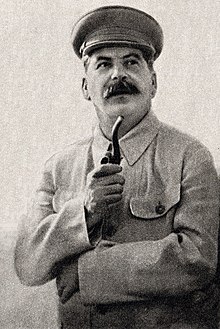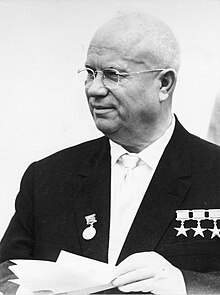User:Md188/Soviet Elections Post Signing of the 1936 Soviet Constitution
Stalin's Soviet Elections (1936-1950) and Impact[edit]

Signing of the 1936 Soviet Constitution[edit]
On December 5th, 1936, the second Soviet Constitution was signed and formally replaced the original constitution of 1924. The new constitution was enacted by the former Congress of Soviets and signed by former General Secretary, Joseph Stalin. As a result, the Congress of Soviets was dismantled and replaced by a new Supreme Soviet. This meant that almost all democratic ideologies used in the previous constitution were forgotten and replaced by totalitarian view points. The new constitution also allowed for one party, known as The Communist Party of the Soviet Union (CPSU) to assume full control of the government with little form of opposition from other parties. However, the new constitution did come with some benefits for the average person. Economic liberties such as the right to work allowed for the average soviet citizen to not be discriminated against in the workplace. Also, protection of leisure time, education, and housing were some of the other benefits Soviet citizens were able to enjoy from the new government.[1]
Structure of the Supreme Soviet[edit]
The new constitution created a bicameral legislature system consisting of two chambers, The Soviet of the Union and The Soviet of Nationalities. The Soviet of the Union was a group of deputies or representatives that entailed one deputy for every 300,000 Soviet citizens. These deputies were directly elected by the Soviet people through a means of universal suffrage. Each deputy was elected for a term of four years. On the other hand, The Soviet of Nationalities was ethnically separated. It consisted of representatives from each of the union republics, autonomous republics, autonomous oblasts, and autonomous okrugs. The union republic was granted 32 deputies, giving them higher power over the other regions/ republics. However, as the list goes down from union republics to autonomous okrugs, less and less deputies were appointed regardless of population size. Similar to The Soviet of the Union, each official was elected for a span of four years.[2]
How Did Soviet Elections Work[edit]
As promised by the new constitution, citizens were granted universal suffrage. This meant that all Soviet citizens who were of age were allowed to vote regardless of their gender, class, and race[3]. However, the voting process was not as democratic as some may expect. In order to avoid division between the CPSU, every candidate had to be approved by the party and usually only one would appear on the ballot. As a result, when it came time to vote many people simply submitted an unmarked ballot with the only candidate listed. This meant that the voter favored the candidate and did not wish to vote for another. However, if a voter decided to vote against the single name ballot, they would be able to enter a private voting booth and write down the name of their preferred candidate. Not many people chose to do this because of the risk that came with it. Publicly showing yourself entering a voting booth was not the safest option, especially during a time of distrust and political oppression. Also, in order for an election to be considered valid, there must have been a voter turnout of at least 50% of the voting population. As a result, the government heavily pushed the citizens to vote.[4]
1937 Election[edit]
Shortly after the signing of the new constitution, elections were held to determine the head of the Soviet Union. As promised by the government a multi-candidate election was held but was soon corrupted after the Great Purge, a time of political distrust and oppression. Many political candidates and threats to the CPSU were arrested as a part of a mass arrest effort to ensure the victory of the Communist party. As a result, one candidate was left standing halfway throughout the election process, Joseph Stalin. Stalin had won both the Soviet of the Union and the Soviet of Nationalities through a landslide vote.[5]
The Great Purge, also known as the Great Terror, was an initiative by Stalin to forcefully keep himself in power after the death of Vladimir Lenin. Many supporters of Lenin and the Bolshevik Party believed that Stalin was not the right choice to lead the Communist nation. However, after Stalin had forced way into power he went after anybody who opposed his rule. He ordered the mass arrests of millions of people, many of which were executed and many more sent to gulags for physical labor. It is believed that at least 725,000 people were killed during this time period, however the number can be much higher since many of the killings were covered up. Also, the Moscow Trials were three high profile trials that publicly accused many high ranking officials of treason. Some of these officials included Aleksei Rykov and Lev Kamenev.[6] It is also worth noting that families were also held liable for the actions of husbands and fathers. Thanks to a new decree signed by Stalin children as young as 12 years old were able to be arrested.[7]
Stalin had won The Soviet of the Union by a vote of 461 deputies to 108. He had also won the The Soviet of the Nationalities by a vote of 409 deputies to 165.
1946 Election[edit]
The night of February 9th, 1946, Stalin walked out onto a stage and was greeted by a grand audience of voters. He proceeded to deliver a speech to those in attendance and for those listening at home through radio or television. In his speech to the voters, he glorifies the Soviet Union's role in the victory of World War 2 and emphasizes the importance of having a strong and successful social system.
“Our victory signifies, first of all, that our Soviet social system was victorious, that the Soviet social system successfully passed the test of fire in the war and proved that it is fully viable.” (Stalin 1945) He also says, “The war proved that the Soviet social system is a genuinely people's system, which grew up from the ranks of the people and enjoys their powerful| support; that the Soviet social system is fully viable and stable form of organization of society.” (Stalin 1945). [8]
The following day the next election for Supreme Soviet was held. Out of an eligible adult population of 101,718,000, approximately 325,000 people were revoked of their voting rights for a multitude of reasons. Also for the first time, members of the Red Army were allowed to cast their votes outside of the Soviet Union. This was because of a new decree or law that was passed in 1945, stating that members of the Red Army would receive voting power within small districts of 100,000 people. As a result, Joseph Stalin was reelected back into power and his reign would continue for the next four years. This time, Stalin received 682 deputy votes within the Soviet of the Union and 657 deputies in the Soviet of Nationalities. This was a large increase from the previous election and showed a positive growth rate for voter support of the reelected leader.[9]
1950 Election[edit]
The 1950 election would be the last election Joseph Stalin would ever run in. Similar to previous elections he was the only name on the ballot. Of the 111,116, 378 million eligible voters, 111,090,010 came to vote. The results showed a large favor for the CPSU as Stalin received 678 votes from the Soviet of The Union and 638 votes from the Soviet of Nationalities.[10]

Stalin's Short Lived Legacy[edit]
Prior to his death in 1953, Stalin began to feel ill and was rarely seen given speeches in public. He spent most of days in his summer estate, Kunstevo Dacha. However, when he finally passed away there was a four day mourning period before anybody could replace his seat.[11] Several high ranking politicians fought amongst each other for the title. Among those was Nikita Khrushchev, former first secretary of the Ukrainian Communist Party. He managed to fight off Georgy Malenkov, Stalin's chosen successor, and earn the title of first secretary of the communist party. However, Khrushchev did not believe in the same harsh tactics Stalin used on his citizens. He released millions of the innocent prisoners from gulags and blamed Stalin for the many economic and political issues that existed in the Soviet Union. [12]
On February 14th, 1956 the Twentieth Congress of The Communist Party of the Soviet Union[13] came together for the first time since the death of their leader. On that night Khrushchev gave his famous speech, "The Personality Cult and its Consequences" to 1,500 attendees. For hours he stood there shaming Stalin for his abusive role in the Communist Party.[14]
"Fearing the future fate of the party and of the Soviet nation, V.I. Lenin made a completely correct characterization of Stalin, pointing out that it was necessary to consider the question of transferring Stalin from the position of Secretary General because of the fact that Stalin is excessively rude, that he does not have a proper attitude toward his comrades, that lie is capricious, and abuses his power." He also said, "Stalin acted not through persuasion, explanation, and patient cooperation with people, but by imposing his concepts and demanding absolute submission to his opinion. Whoever opposed this concept or tried to prove his viewpoint, and the correctness of his position was doomed to removal from the leading collective and to subsequent moral and physical annihilation" [15]
After his speech, Khrushchev made it his goal to remove as much of Stalin's loyalists from office and steer the Soviet Union into a new direction. He dreamed of creating a Communist state that could live in peace with others and solve problems diplomatically rather than forcefully. Later on in 1961 Khrushchev once again went onto publicly shame Stalin for his actions. He even had Stalin's body removed from its resting spot in the Red Square, right beside the body of Vladimir Lenin. [16]
References[edit]
- ^ "1936 Constitution of the Soviet Union", Wikipedia, 2021-04-14, retrieved 2021-04-18
- ^ "Supreme Soviet of the Soviet Union", Wikipedia, 2021-03-25, retrieved 2021-04-18
- ^ "Elections in the Soviet Union", Wikipedia, 2020-09-06, retrieved 2021-04-19
- ^ How did Soviet Elections Work? (Short Animated Documentary), retrieved 2021-04-19
- ^ "1937 Soviet Union legislative election", Wikipedia, 2021-03-21, retrieved 2021-04-19
- ^ "Moscow Trials", Wikipedia, 2021-04-02, retrieved 2021-04-19
- ^ Editors, History com. "Great Purge". HISTORY. Retrieved 2021-04-19.
{{cite web}}:|last=has generic name (help) - ^ "Wilson Center Digital Archive". digitalarchive.wilsoncenter.org. Retrieved 2021-04-18.
- ^ "1946 Soviet Union legislative election", Wikipedia, 2021-03-18, retrieved 2021-04-19
- ^ "1950 Soviet Union legislative election", Wikipedia, 2020-11-19, retrieved 2021-04-19
- ^ "Kuntsevo Dacha", Wikipedia, 2021-02-08, retrieved 2021-04-18
- ^ Editors, History com. "Nikita Khrushchev elected Soviet leader". HISTORY. Retrieved 2021-04-18.
{{cite web}}:|last=has generic name (help) - ^ "20th Congress of the Communist Party of the Soviet Union", Wikipedia, 2021-01-15, retrieved 2021-04-19
- ^ "Stalin Denounced by Nikita Khrushchev | History Today". www.historytoday.com. Retrieved 2021-04-18.
- ^ "Wilson Center Digital Archive". digitalarchive.wilsoncenter.org. Retrieved 2021-04-18.
- ^ "Stalin Denounced by Nikita Khrushchev | History Today". www.historytoday.com. Retrieved 2021-04-19.
